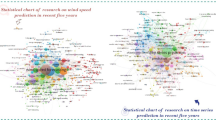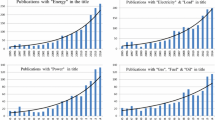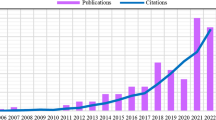Abstract
Wind energy, as one of the renewable energies with the most potential for development, has been widely concerned by many countries. However, due to the great volatility and uncertainty of natural wind, wind power also fluctuates, seriously affecting the reliability of wind power system and bringing challenges to large-scale grid connection of wind power. Wind speed prediction is very important to ensure the safety and stability of wind power generation system. In this paper, a new wind speed prediction scheme is proposed. First, improved hybrid mode decomposition is used to decompose the wind speed data into the trend part and the fluctuation part, and the noise is decomposed twice. Then wavelet analysis is used to decompose the trend part and the fluctuation part for the third time. The decomposed data are classified. The long- and short-term memory neural network optimized by the improved particle swarm optimization algorithm is used to train the nonlinear sequence and noise sequence, and the autoregressive moving average model is used to train the linear sequence. Finally, the final prediction results were reconstructed. This paper uses this system to predict the wind speed data of China’s Changma wind farm and Spain’s Sotavento wind farm. By experimenting with the real data from two different wind farms and comparing with other predictive models, we found that (1) by improving the mode number selection in the variational mode decomposition, the characteristics of wind speed data can be better extracted. (2) According to the different characteristics of component data, the combination method is selected to predict modal components, which makes full use of the advantages of different algorithms and has good prediction effect. (3) The optimization algorithm is used to optimize the neural network, which solves the problem of parameter setting when establishing the prediction model. (4) The combination forecasting model proposed in this paper has clear structure and accurate prediction results. The research work in this paper will help to promote the development of wind energy prediction field, help wind farms formulate wind power regulation strategies, and further promote the construction of green energy structure.










Similar content being viewed by others
Abbreviations
- ANN:
-
Artificial neural network
- ARMA:
-
Autoregressive moving average
- ARIMA:
-
Autoregressive integrated moving average
- BP:
-
Back propagation
- CEEMDAN:
-
Fully integrated empirical mode decomposition
- EMD:
-
Empirical mode decomposition
- EEMD:
-
Set empirical mode decomposition
- FCBF:
-
Fast correlation filter algorithm
- HMD:
-
Hybrid mode decomposition
- LIDAR:
-
Light detection and ranging
- LSTM:
-
Long- and short-term memory neural network
- IMF:
-
Intrinsic mode functions
- IPSO:
-
Improved particle swarm optimization
- MAE:
-
Mean absolute error
- MIV:
-
Mean impact value
- MSE:
-
Mean square error
- MAPE:
-
Mean absolute percentage error
- NCL-RELM:
-
Negative correlation learning-based regularized extreme learning machine ensemble model
- NWP:
-
Numerical weather prediction
- OVMD:
-
Optimal variational mode decomposition
- PSO:
-
Particle swarm optimization
- RBF:
-
Radial basis function
- RMSE:
-
Root mean square error
- RNN:
-
Cyclic neural network
- SODAR:
-
Sound detection and ranging
- SVM:
-
Support vector machine
- VMD:
-
Variational mode decomposition
- WT:
-
Wavelet transform
- WD:
-
Wavelet decomposition
- WPD:
-
Wavelet packet decomposition
References
Chen B (2020) Short term wind power forecasting based on wind speed characteristics analysis. North China Electric Power University
Cao YK, Hu QQ, Shi H, Zhang Y (2019) Prediction of wind power generation base on neural network in consideration of the fault time. IEEJ Trans Electr Electron Eng 14(5):670–679. https://doi.org/10.1002/tee.22853
Chaurasiya PK, Warudkar V, Ahmed S (2017) Wind characteristics observation using Doppler-SODAR for wind energy applications. Resource-Efficient Technol 3(4):495–505. https://doi.org/10.1016/j.reffit.2017.07.001
Chaurasiya PK, Warudkar V, Ahmed S (2018a) Comparative analysis of Weibull parameters for wind data measured from met-mast and remote sensing techniques. Renew Energy 115:1153–1165. https://doi.org/10.1016/j.renene.2017.08.014
Chaurasiya PK, Warudkar V, Ahmed S (2018b) Study of different parameters estimation methods of Weibull distribution to determine wind power density using ground based Doppler SODAR instrument. Alexandria Eng J 57(4):2299–2311. https://doi.org/10.1016/j.aej.2017.08.008
Chaurasiya PK, Warudkar V, Ahmed S (2019) Wind energy development and policy in India: a review. Energy Strategy Rev 24:342–357
Chitsaz H, Amjady N, Zareipour H (2015) Wind power forecast using wavelet neural network trained by improved Clonal selection algorithm. Energy Convers Manag 89:588–598. https://doi.org/10.1016/j.enconman.2014.10.001
Dang XJ, Chen HY, Jin XM. (2013) A method for forecasting short-term wind speed based on EMD and SVM. 2645:622-627. https://doi.org/10.4028/www.scientific.net/AMM.392.622
Dragomiretskiy K, Zosso D (2014) Variational mode decomposition. IEEE Trans Signal Process 62:531–544. https://doi.org/10.1109/TSP.2013.2288675
Erdem E, Shi J (2011) ARMA based approaches for forecasting the tuple of wind speed and direction. Appl Energy 88:1405–1414. https://doi.org/10.1016/j.apenergy.2010.10.031
Glowacz A (2018) Acoustic-Based Fault Diagnosis of Commutator Motor. Electronics 299. https://doi.org/10.3390/electronics7110299
Glowacz A (2019) Fault diagnosis of single-phase induction motor based on acoustic signals. Mech Syst Signal Process 117:65–80. https://doi.org/10.1016/j.ymssp.2018.07.044
Glowacz A, Glowacz W (2018) Vibration-based fault diagnosis of commutator motor. Shock and Vibration 1–10. https://doi.org/10.1155/2018/74604192018/7460419
Gu B, Zhang TR, Meng H et al (2020) Short-term forecasting and uncertainty analysis of wind power based on long short-term memory, cloud model and non-parametric kernel density estimation. Renew Energy 164:687–708. https://doi.org/10.1016/j.renene.2020.09.087
Harty TM, Holmgren WF, Lorenzo AT, Morzfeld M (2019) Intra-hour cloud index forecasting with data assimilation. Sol Energy 185:270–282. https://doi.org/10.1016/j.solener.2019.03.065
Higashiyama K, Fujimoto Y, Hayashi Y (2018) Feature extraction of NWP data for wind power forecasting using 3D-convolutional neural networks. Energy Procedia 155:350–358. https://doi.org/10.1016/j.egypro.2018.11.043
Hodge B-M, Zeiler A, Brooks D, Blau G, Reklatis G (2011) Improved wind power forecasting with ARIMA models. Comp Aided Chem Eng 29:1789–1793. https://doi.org/10.1016/B978-0-444-54298-4.50136-7
Hu H, Lin W, Lv S-X (2020) Forecasting energy consumption and wind power generation using deep echo state network. Renew Energy 154:598–613. https://doi.org/10.1016/j.renene.2020.03.042
International Renewable Energy Agency’s (IRENA). (2020) 2020 Annual renewable energy report [EB/OL], https://www.iea.org/, 2020-4-13 /2020-10-20.
Li YF, Shi HP, Han FZ, Liu H (2019a). Smart wind speed forecasting approach using various boosting algorithms, big multi-step forecasting strategy. 135540-553. https://doi.org/10.1016/j.encon.man.2017.05.063
Li YN, Yang P, Wang HJ (2019b) Short-term wind speed forecasting based on improved ant colony algorithm for LSSVM. Clust Comput 22:11575–11581. https://doi.org/10.1007/s10586-017-1422-2
Liu H, Duan Z, Han FZ, Li YF (2018a) Big multi-step wind speed forecasting model based on secondary decomposition, ensemble method and error correction algorithm. Energy Convers Manag 156:525–541. https://doi.org/10.1016/j.enconman.2017.11.049
Liu H, Mi XW, Li YF (2018b) Comparison of two new intelligent wind speed forecasting approaches based on wavelet packet decomposition, complete ensemble empirical mode decomposition with adaptive noise and artificial neural networks. Energy Convers Manag 155:188–200. https://doi.org/10.1016/j.enconman.2017.10.085
National Energy Administration. (2020) Transcript of national energy administration's online press conference in the third quarter of 2020 [EB/OL], http://www.nea.gov.cn/
Nazir MS, Ali ZM, Bilal M, Sohail HM, Iqbal HMN (2020a) Environmental impacts and risk factors of renewable energy paradigm—a review. Environ Sci Pollut Res 27:1–11. https://doi.org/10.1007/s11356-020-09751-8
Nazir MS, Bilal M, Sohail HM, Liu B, Wan C, Iqbal HMN (2020b) Impacts of renewable energy atlas: reaping the benefits of renewables and biodiversity threats. Int J Hydrog Energy 45:22113–22124. https://doi.org/10.1016/j.ijhydene.2020.05.195
Nourani Esfetang N, Kazemzadeh R (2018) A novel hybrid technique for prediction of electric power generation in wind farms based on WIPSO, neural network and wavelet transform. Energy 149:662–674. https://doi.org/10.1016/j.energy.2018.02.076
Peng T, Zhang C, Zhou J, Nazir MS (2020) Negative correlation learning-based RELM ensemble model integrated with OVMD for multi-step ahead wind speed forecasting. Renew Energy 156:804–819. https://doi.org/10.1016/j.renene.2020.03.168
Shahid F, Zameer A, Mehmood A, et al. (2020) A novel wavenets long short-term memory paradigm for wind power prediction. 269. https://doi.org/10.1016/j.apenergy.2020.115098
Sharifian A, Ghadi MJ, Ghavidel S, Li L, Zhang JF (2018) A new method based on type-2 fuzzy neural network for accurate wind power forecasting under uncertain data. Renew Energy 120:220–230. https://doi.org/10.1016/j.renene.2017.12.023
Skittides C, Früh W-G (2014) Wind forecasting using principal component analysis. Renew Energy 69:365–374. https://doi.org/10.1016/j.renene.2014.03.068
Tang B, Chen Y, Chen Q et al (2020) Research on short-term wind power forecasting by data mining on historical wind resource. Appl Sci 10(4):1295. https://doi.org/10.3390/app10041295
Tian Z, Ren Y, Wang G (2019) Short-term wind speed prediction based on improved PSO algorithm optimized EM-ELM. Energy Sources Part A: Recovery, Utilization, and Environmental Effect 41(1):26–46
Wang SX, Zhang N, Wu L et al (2016) Wind speed forecasting based on the hybrid ensemble empirical mode decomposition and GA-BP neural network method. Renew Energy 94:629–636. https://doi.org/10.1016/j.renene.2016.03.103
Wang SX, Li M, Zhao L et al (2019) Short-term wind power prediction based on improved small-world neural network. Neural Comput & Applic 31:3173–3185. https://doi.org/10.1007/s00521-017-3262-7
Wu JS, Long J, Liu MZ (2015) Evolving RBF neural networks for rainfall prediction using hybrid particle swarm optimization and genetic algorithm. Neurocomputing 148:136–142. https://doi.org/10.1016/j.neucom.2012.10.043
Yu CJ, Li YL, Zhang MJ (2017) An improved wavelet transform using singular spectrum analysis for wind speed forecasting based on Elman neural network. Energy Convers Manag 148:895–904
Yuan XH, Chen C, Yuan YB, Huang YH, Tan QX (2015) Short-term wind power prediction based on LSSVM–GSA model. Energy Convers Manag 101:393–401. https://doi.org/10.1016/j.enconman.2015.05.065
Zafirakis D, Tzanes G, Kaldellis JK (2019) Forecasting of wind power generation with the use of artificial neural networks and support vector regression models. Energy Procedia 159:509–514. https://doi.org/10.1016/j.egypro.2018.12.007
Zendehboudi A, Baseer MA, Saidur R (2018) Application of support vector machine models for forecasting solar and wind energy resources: a review. J Clean Prod 199:272–285. https://doi.org/10.1016/j.jclepro.2018.07.164
Zhang YG, Pan GF (2020) A hybrid prediction model for forecasting wind energy resources. Environ Sci Pollut Res 16:19428–19446
Zhang DL, Li SS, He XD (2015) RBF neural network wind power prediction based on chaos theory. Adv Mater Res 3701:315–318. https://doi.org/10.4028/www.scientific.net/AMR.1070-1072.315
Zhang L, Wang K, Lin WL, et al. (2019a) Wind power prediction based on improved genetic algorithm and support vector machine. 252(3)
Zhang YG, Chen B, Pan GF, Zhao Y (2019b) A novel hybrid model based on VMD-WT and PCA-BP-RBF neural network for short-term wind speed forecasting. Energy Convers Manag 195:180–197. https://doi.org/10.1016/j.enconman.2019.05.005
Zhang Y, Zhang C, Gao S, Wang P, Xie F, Cheng P, Lei S (2020a) Wind speed prediction using wavelet decomposition based on lorenz disturbance model. IETE J Res 66:635–642. https://doi.org/10.1080/03772063.2018.1512384
Zhang YG, Pan GF, Chen B, Han JY, Zhao Y, Zhang CH (2020b) Short-term wind speed prediction model based on GA-ANN improved by VMD. Renew Energy 156:1373–1388
Zhang YG, Pan GF, Zhao YP, Qian L, Wang F (2020c) Short-term wind speed interval prediction based on artificial intelligence methods and error probability distribution. Energy Convers Manag 224:1–14
Zhang Y, Han J, Pan G, Xu Y, Wang F (2021) A multi-stage predicting methodology based on data decomposition and error correction for ultra-short-term wind energy prediction. J Clean Prod 292:1–19. https://doi.org/10.1016/j.jclepro.2021.125981
Zhao QD, Yu Y, Jia MM. (2014) Applied-information technology in short-term wind speed forecast model for wind farms based on ant colony optimization and bp neural network. 3563:259-262. https://doi.org/10.4028/www.scientific.net/AMM.662.259
Acknowledgements
The authors thank Dr. Marcus Schulz and the anonymous referees for the thoughtful and constructive suggestions that led to a considerable improvement of the paper.
Availability of data and materials
The datasets used or analyzed during the current study are available from the corresponding author on reasonable request.
Funding
This research was supported partly by the National Natural Science Foundation of China (51637005) and the S&T Program of Hebei (G2020502001).
Author information
Authors and Affiliations
Contributions
Yagang Zhang: Conceptualization, methodology, software, and writing original draft. Ruixuan Li: Methodology and performed the experiments. Jinghui Zhang: Writing review and editing
Corresponding author
Ethics declarations
Ethics approval and consent to participate
Not applicable
Consent for publication
Not applicable
Competing interests
The authors declare no competing interests.
Additional information
Responsible editor: Marcus Schulz
Publisher’s note
Springer Nature remains neutral with regard to jurisdictional claims in published maps and institutional affiliations.
Rights and permissions
About this article
Cite this article
Zhang, Y., Li, R. & Zhang, J. Optimization scheme of wind energy prediction based on artificial intelligence. Environ Sci Pollut Res 28, 39966–39981 (2021). https://doi.org/10.1007/s11356-021-13516-2
Received:
Accepted:
Published:
Issue Date:
DOI: https://doi.org/10.1007/s11356-021-13516-2




